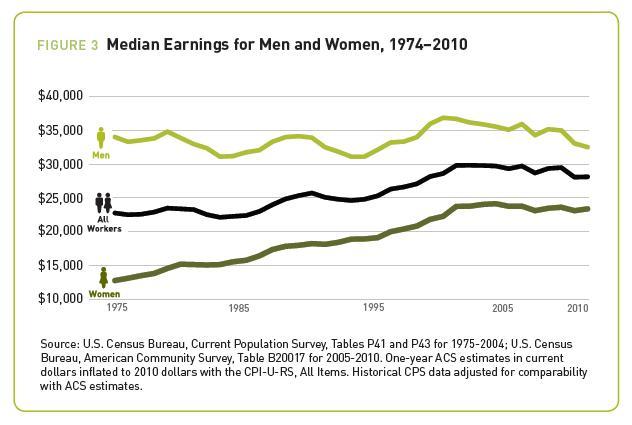What Happened To Earnings During the Recession?
On September 22, 2011, the U.S. Census Bureau released the latest findings from the annual American Community Survey. The American Human Development Project’s analysis of these data reveal the ways in which the Great Recession impacted the earnings of different groups of Americans. The image below shows the change in earnings for men and women over time (updated from The Measure of America 2010-2011). 
These resources show changes in median personal earnings between 2007 and 2010 by gender, race and ethnicity, and educational levels as well as changes in select occupational categories:
- Earnings Gaps by Gender, Race and Education [pdf]
- Changes in Earnings During the Recession in Selected Sectors [pdf]
Median personal earnings are the wages and salaries of all workers, full- and part-time, age 25 and up; this measure does not include other sources of income, such as interest, dividends, or capital gains, nor does it include assets like real estate.
SOME STRIKING TRENDS
- The impact of the recession on individual earnings varied tremendously based on educational level. For instance, while median earnings dropped for all workers over the period 2007-2010 (by 5.3 percent), those who never completed high school saw a loss of earnings more than three times greater than those with a graduate or professional degree—9.8 percent vs. 2.8 percent.
- At every educational level, women fared better than men. Male earnings fell by $2,433; female earnings fell by about one tenth as much ($253). However, despite the volatility in men’s earnings during this period, men still outearn women by a large margin. In fact, the typical male worker with a bachelor’s degree earns about $5,000 more than the typical female worker with a graduate degree.
- Latino men saw the biggest drop in their earnings, an 11% drop from 2007 to 2010.
- Sectors dominated by men shed jobs disproportionately from 2007 to 2010; for instance, the number of men employed in construction and extraction occupations over this period decreased by 1.4 million workers.
- The total number of women in management, business, financial occupations, and service occupations increased, but their real earnings in these sectors did not.
FURTHER RESOURCES
- The Measure of America 2010-2011: American Human Development Report
- Mapping the Measure of America: Interact with over 100 indicators in health, education, income, and more.
- Need data? See what AHDP can do for you.
____________________________________________________________________________
For media inquiries: John Keaten | jkeaten@groupgordon.com | (212) 784-5701
Questions? Email: contact@measureofamerica.org